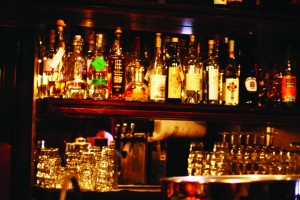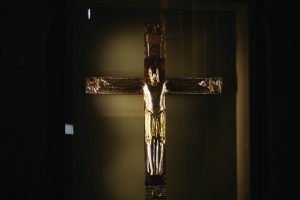Heather Crombie visits the historic university city of Pavia and discovers a rich tradition of art, history and a timeless appeal that has inspired some of history’s greatest minds…
Having a river running along the edges of a city always gives it a head start in terms of aesthetic appeal, and it is the river I saw first when entering Pavia. Arriving at night, lights reflected off the water and illuminated the covered bridge that spans the Ticino. Pavia is a thriving, energetic city with the university at its heart. Once the capital of the Lombardy region, Pavia is a wonderful place in which to wander, with an atmosphere that is at once vibrant and friendly with the energy of a student town and the cultural richness of a city steeped in history and tradition.
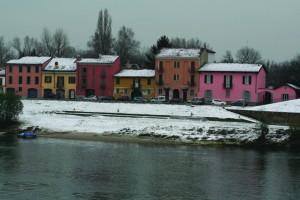 On my first morning in Pavia I was struck by the higgledy-piggledy skyline of medieval rooftops. I met the extremely dapper Ivan Fowler who was to conduct me on a walking tour of the area. This was a good way to make my acquaintance with the city as I gained a valuable insight into its hidden corners and famous monuments, as well as tantalising glimpses of some of the shops, bars and intriguing side-streets that I wanted to explore further. A great place to start is at the university, with austere courtyards surrounded by graceful stone arches that lead you into the various educational departments. The university is one of the oldest in Europe, having existed as an institution since 825 AD and being officially founded in 1361. Pavia’s cultural life is intertwined with the university across the entire city, with museums in the north, south, east and west. In the centre of Pavia at the heart of the campus, the Museo per la Storia dell’Università is a treasure trove of scientific discovery, with so many fascinating exhibits it was quite hard for me to focus on just one thing at a time.
On my first morning in Pavia I was struck by the higgledy-piggledy skyline of medieval rooftops. I met the extremely dapper Ivan Fowler who was to conduct me on a walking tour of the area. This was a good way to make my acquaintance with the city as I gained a valuable insight into its hidden corners and famous monuments, as well as tantalising glimpses of some of the shops, bars and intriguing side-streets that I wanted to explore further. A great place to start is at the university, with austere courtyards surrounded by graceful stone arches that lead you into the various educational departments. The university is one of the oldest in Europe, having existed as an institution since 825 AD and being officially founded in 1361. Pavia’s cultural life is intertwined with the university across the entire city, with museums in the north, south, east and west. In the centre of Pavia at the heart of the campus, the Museo per la Storia dell’Università is a treasure trove of scientific discovery, with so many fascinating exhibits it was quite hard for me to focus on just one thing at a time.
AN ILLUSTRIOUS HISTORY
Anatomy has been studied at the University of Pavia for hundreds of years. Indeed, Leonardo da Vinci did many of his anatomical investigations here between 1510-11. Pavia was at the forefront of this area of study, and the Anatomy Rooms at the museum remain under the watchful eye of Dr Antonio Scarpa – the Professor of Anatomy at the university who died in 1832. He left his body to be studied by the university, and his preserved head is now one of the museum exhibits.
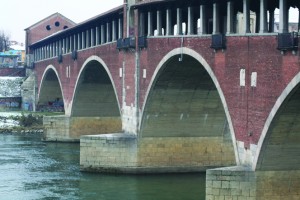 Here also is a letter from Albert Einstein to Ernesta Pelizza Marangoni, a doctor with whom Einstein stayed when visiting Pavia. They corresponded regularly, and in this letter Einstein is replying to a request that he assist with the doctor’s negotiations for rebuilding the covered bridge that had been destroyed in the war. His reply was not encouraging, but his tone to the doctor is warm and he includes a line or two about the fate of Mussolini, illustrated with a darkly humorous cartoon of a scaffold.
Here also is a letter from Albert Einstein to Ernesta Pelizza Marangoni, a doctor with whom Einstein stayed when visiting Pavia. They corresponded regularly, and in this letter Einstein is replying to a request that he assist with the doctor’s negotiations for rebuilding the covered bridge that had been destroyed in the war. His reply was not encouraging, but his tone to the doctor is warm and he includes a line or two about the fate of Mussolini, illustrated with a darkly humorous cartoon of a scaffold.
The university curates a network of museums throughout Pavia, including collections relating to geology, natural history and electricity (Volta developed the first battery here). One of the collections that I was most interested in was the botanical specimens in the Orto Botanico. In the east of the city, the botanical garden is a wonderful place to enjoy a tranquil stroll, with impressive collections of cacti, roses, tropical shrubs and broad-leafed trees. The garden has expanded from its original site over the last hundred years to become both an elegant visitor attraction and a centre for botanical research.
Leaving the delights of the botanical garden and heading back into the town centre, I was about ready for a sustaining cup of coffee and a slice of torta paradiso (or ‘paradise cake’) which is a speciality of the city. This deliciously dense, sweet sponge cake has become a symbol of the city and is the perfect accompaniment to an espresso.
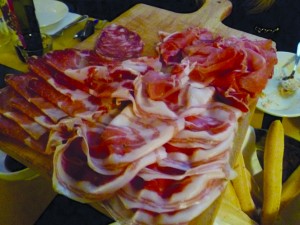 Pavia is probably my favourite foodie place in Lombardy, perhaps because of all the sweet treats on offer. I spoke to some of the staff at I Viaggi di Tels, who have recently combined their love of cooking with their community spirit and written up classic recipes from Lombardy and around the world in order to raise money for linguistic projects in local schools. The Maria Fuga Cooking Club includes delights such as persimmon semifreddo and apple cake. I sampled a variety of delicacies whilst in the city at a selection of cafés and restaurants, and was not disappointed by what I tasted.
Pavia is probably my favourite foodie place in Lombardy, perhaps because of all the sweet treats on offer. I spoke to some of the staff at I Viaggi di Tels, who have recently combined their love of cooking with their community spirit and written up classic recipes from Lombardy and around the world in order to raise money for linguistic projects in local schools. The Maria Fuga Cooking Club includes delights such as persimmon semifreddo and apple cake. I sampled a variety of delicacies whilst in the city at a selection of cafés and restaurants, and was not disappointed by what I tasted.
SHOPPING IN PAVIA
There’s nothing like coffee and cake to set you up for a bout of serious shopping, and Pavia is a wonderful place to spend some money. The window displays are artfully designed, and there is such a variety of interesting emporiums I had to be very firm with myself to avoid a rather expensive spree! Perhaps it is because I don’t have a designer budget, but I much preferred the Pavia shopping experience to the glitz of the Milan malls.
If you’re visiting around Easter or Christmas, expect to be spoilt for choice in terms of seasonal gifts. The rest of the year, present-shopping is made easy with an array of quirky and bespoke items from a range of boutiques within an easy stroll of each other. There were some gorgeous displays on the Corso Garibaldi which made even window-shopping a satisfying experience. Piazza della Vitoria hosts seasonal outdoor markets depending on the time of year, but there is also a year-round underground market selling a great variety of goods, including food stalls that are particularly popular.
As you might expect from a university town, there is plenty to do in the evenings. Relaxing over a leisurely meal in one of the many restaurants is an event in itself, or get a quick bite to eat and take in a performance at Fraschini Theatre on Corso Strada Nuova. Behind the unassuming exterior lies a beautiful auditorium, opulently decorated. They have a varied programme of performances throughout the year, so it’s best to check the website in advance to see if there’s anything you fancy when you visit.
Pavia has been called the city of the one hundred towers. Although it does not boast quite so many these days, you can still see remarkable examples of Romanesque architecture and, yes, a fair few towers. The church of San Michele Maggiore has a stunning exterior, with ornate 12th-century carving around the main door. This church is particularly important as it was once the place where the coronations of Italian kings took place. Inside I noticed beautiful frescoes, and some paintings by Moncalvo too. It is definitely a place not to be missed during a visit to the city.
The cathedral in Pavia is also truly splendid, an elegant structure of Lombard red brick, with an interior of soaring white marble arches. Leonardo da Vinci was brought in as an engineer to help construct the cathedral at the behest of Ludovico il Moro, the Duke of Milan. He wanted to build the biggest church in the world, and although he did not succeed (it is actually the fourth largest in Italy) the cathedral is still a uniquely beautiful structure. Its construction also brought da Vinci into contact with Francesco di Giorgio, who had previously translated the Latin works of Vitruvius. This was crucial to da Vinci’s career, influencing his ideas regarding architecture and design, and the concept of the ‘ideal’ human form.
If the cathedral is the jewel in Pavia’s crown, there are certainly a fair few gems sparkling alongside it. There are 60 churches in the city, most of which are built in the Romanesque style, which makes it a pilgrimage site not only for religious devotees but for devotees of architecture and history as well.
I was particularly enamoured by the Lombard red brick that so many of the buildings are made from, a material that was also used in constructing bridges. The Ponte Coperto was rebuilt using brick and stone after the original 14th-century construction was all but destroyed in World War II (the subject of Dr Marangoni’s letter to Albert Einstein). This bridge is a Lombard landmark, with a little chapel in the middle housing one of the wooden statues that was rescued from the river, along with some original columns which were restored. When the water is low you can see the stumps of the Roman bridge, and imagine Hannibal leading his Carthaginian army (including elephants) across the river during the Punic wars.
There is so much to experience in Pavia, 48 hours is just enough time to get a flavour of the place – and plan when your next trip will be. When I next visit I intend to explore the surrounding paddy fields and vineyards that sweep out to the mountains. I may even pick up the Lombardy wine trail which starts in Oltrepò Pavese.
Perhaps the Castello Visconteo (now the Civic Museum) will keep me from overspending at the shops, or perhaps I will simply sit by the Ticino with a slice of torta paradiso and appreciate the beauty of a Lombard jewel.
GETTING THERE
– By Plane
If you fly to Milan Linate or Malpensa, Pavia is an hour’s journey away in a hire car. Bergamo Orio al Serio or Brescia-Montichiari (Gabriele D’Annunzio) are alternative airports that serve Pavia.
– By Train
Pavia’s train station is located in Piazzale della Stazione in the northwest of the city. It is on the Milan-Genova line and there are regular services (buses also available). It takes about 30 minutes to get to Pavia from Milan by train.
– By Car
Pavia is around 30km south of the tangenziale (Milan ring road), coming off at the Bereguardo exit. The A7 and A21 motorways connect Pavia to the rest of Italy.


